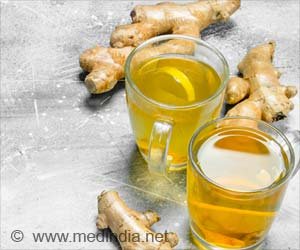Pungent Compound in Ginger Puts Immune System on Alert

The consumption of ginger in the western world has increased, although the East has always been an avid user. Ginger is used as a common spice in Asian cuisines. Ginger may help relieve nausea and vomiting and aid digestion. Antioxidants and other nutrients in ginger root may help prevent or treat arthritis, inflammation, and various types of infections. Ginger may also reduce the risk of diabetes, cancer, and other health problems.
However, even though ginger consumption has increased, the question arises as to whether normal consumption levels are sufficient to achieve health effects. And if so, which compounds and molecular mechanisms play a role in this.
When does the Pungent Compound in Ginger Enter the Body
A previous study shows that significant amounts of pungent ginger compounds, gingerol enter the blood about 30 to 60 minutes after consuming one liter of ginger tea. By far the highest levels were achieved by [6]-gingerol, which is the major pharmacologically active component of ginger, with plasma concentrations of approximately 7 to 17 micrograms per liter (1✔ ✔Trusted Source
[6]-Gingerol Facilitates CXCL8 Secretion and ROS Production in Primary Human Neutrophils by Targeting the TRPV1 Channel
Go to source
).
Advertisement
The pungent compound is known to exert its “taste” effect via the so-called TRPV1 (Transient receptor potential vanilloid 1) receptor, an ion channel located on the surface of nerve cells that responds to painful heat stimuli as well as to pungent compounds from chili and ginger. Since some studies suggest that white blood cells also possess this receptor, the research team tested whether [6]-gingerol influences the activity of these immune cells.
Pungent Compound in Ginger Stimulates White Blood Cells
In a first step, the team succeeded in detecting the receptor on neutrophil granulocytes. These cells make up about 75 percent of white blood cells and serve to combat invading bacteria.
Further laboratory experiments by the research group also showed that even a very low concentration of almost 15 micrograms of [6]-gingerol per liter is sufficient to put the cells on heightened alert. Thus, compared to control cells, the stimulated cells reacted about 30 percent more strongly to a peptide that simulates a bacterial infection. Addition of a TRPV1 receptor-specific inhibitor reversed the effect induced by [6]-gingerol.
Researchers say that at least in experiments, very low [6]-gingerol concentrations are sufficient to affect the activity of immune cells via the TRPV1 receptor. In blood, these concentrations could theoretically be achieved by consuming about one liter of ginger tea.
So, the results support the assumption that the intake of common amounts of ginger may be sufficient to modulate cellular responses of the immune system. Nevertheless, there are still many unanswered questions at the molecular, epidemiological, and medical levels that need to be addressed with the help of modern food and health research.
Reference:
- [6]-Gingerol Facilitates CXCL8 Secretion and ROS Production in Primary Human Neutrophils by Targeting the TRPV1 Channel – (https:pubmed.ncbi.nlm.nih.gov/36564924/)
Source: Medindia
Source link
#Pungent #Compound #Ginger #Puts #Immune #System #Alert



